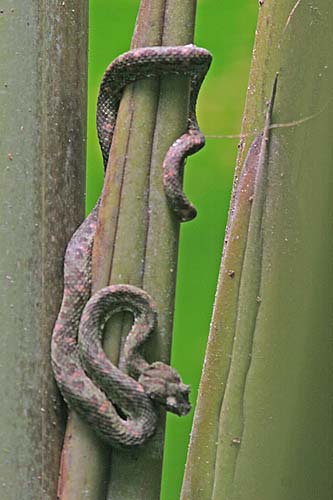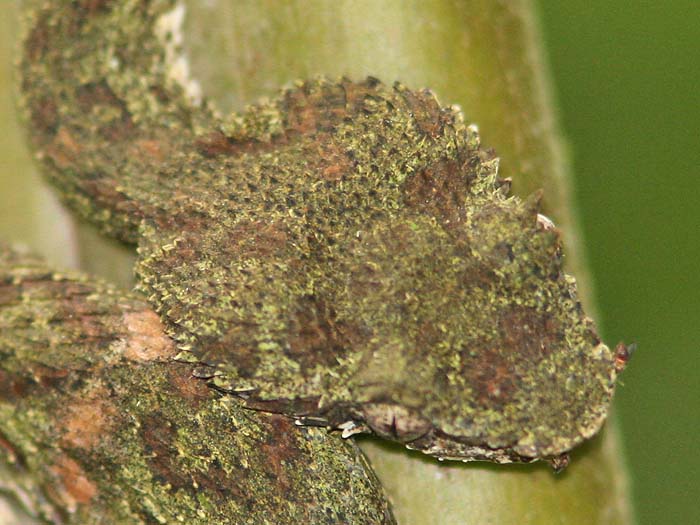| |
| Costa
Rica is a remarkable place for amphibians and reptiles, known to
amateur naturalists as herps. There are about 400 species recorded from
this small country, and there is an excellent (and very thick)
reference book (Savage 2002). During our visit in late December 2007,
we tried to see as many herps as reasonably possible while birding,
looking for mammals, and taking photos of dragonflies. No doubt this
scattering of attention reduced the number of individuals found, but I
was quite happy with the photographic results (below). Identification
was initially sorted out using Savage (2002) with input from our local
guides, Internet resources, and John Sullivan, but there were still
questions. At that point a professional was needed, and I thank Gerardo
Chaves of Museo de Zoologia-Universidad de Costa Rica for identifying
those that remained uncertain. |
AMPHIBIANS
in practical terms, these were frogs and toads [Order Anura] as we did not find salamanders or caecilians on this trip. |
|
No, this isn't a picture of Spider-Man in the Costa Rican jungle . . .
It is a shot a poison-dart frog, Bluejeans Dart Frog Dendrobates (Oophaga) pumilio.
This is one of 8 species of Family Dendrobatidae in Costa Rica (~187
species in the Neotropics), and one of 5 that are poisonous. This
little frogs, only an inch long, accumulate toxins in their skin from
what they eat — young raised in captivity without wild food do not
become poisonous. Their bright colors advertise to predators that they
are poisonous to eat. If you pick one up with any cut or scratch on
your hand, it will burn for some time. Natives used the toxins of some
South American species to dip arrows. |
|
|
| Much research on the life history of Bluejeans Dart Frog
(above) has been done at La Selva Biological Research Center, where the
species is common in the forest. And what a remarkable life history it
is! Males maintain a small territory and will fight any male that
enters. These wrestling matches can last up to 20 minutes. A female
enters a territory to mate, and a small clutch of eggs (3-5) is laid.
The male returns daily to that spot to keep the eggs moist. When they
hatch in ~2 weeks, the female returns and carries each tadpole, often
one at a time, to individual tiny pools of water in bromeliads. Each
tadpole must be in its own pool with nothing else. The female returns
daily to feed the tadpoles by laying unfertilized eggs in the pool for
the tadpole to eat! The tadpole has a 'begging behavior' to stimulate
its mother to do this. In about 6 weeks the tadpoles transform to
adults and hop away. I could not have imagined this incredible life
history (summarized from Savage 2002). |
|
 |
We searched for several other species of poison-dart frog during our trip, but saw only one more species: this attractive Golfo Dulce Dart Frog Phyllobates vittatus.
It is endemic to southwest Costa Rica on the Osa Peninsula and
vicinity. Abram at Rio Tigre lodge took me to see this one, where we
waded up a small rocky stream. In this species the male carries the
tadpoles to little pools for their continued development, but these are
apparently not fed by the female, so they find food in the pool. |
|
| Some
members of the "poison-dart frog" family, the Dendrobatidae, are not
poisonous. They do not extract and store toxins in their skin. These
are not as brightly colored as the poisonous species and tend to be shy
and nervous. Indeed, one name for this group is "rocket frogs" for
their habitat of rocketing away in bounds when they feel threatened. At
Rio Tigre, we found one such species: Talamancan Rocket Frog Colostethus (Allobates) talamancae.
Males transport 8-29 tadpoles on their backs from the leaf-litter where
they hatch to small water-filled depressions in small streams (Savage
2002). |
|
|
| Small
frogs were also in the leaf-litter of the forest at Rio Tigre, Osa
Peninsula. I struggled to sort these out on my return with Savage
(2002); that effort failed. Gerardo Chaves graciously identified the
photos for me: Common Rain Frog Craugastor fitzingeri
(right), Slim-fingered Rain Frog C. crassidigitus (below left) and Stejneger's Rain Frog C. stejnegerinanus (below right). The latter was confused with Bransford's Rain Frog until sorted out
through molecular evidence (Miyamoto 1983). |
|
|
|
Savage (2002) included all these within the genus Eleutherodactylus,
and some on-line sources still do so. However, Heinicke (2007)
presented biochemical evidence that various taxa within that enlarged
genus had diverged 30-40 million years ago, and restricted Eleutherodactylus to the Caribbean herpetofauna, preferring Craugastor
for many of the tiny Middle American frogs. All of the species I
photographed are primarily nocturnal species, often calling throughout
the dark hours from a perch, but living in the leaf-litter of the
forest during the day.
Rapid changes in
scientific nomenclature among amphibians and reptiles, much of it the
result of biochemical analysis, has stirred passions among
herpetologists and created a division between taxonomists and field
ecologists (see Smith & Chiszar 2006). I have placed some of the
newer genera names in parentheses in recognitions of this on-going
debate. I thank John Sullivan for bringing this to my attention. |
|
| The one toad encountered was Cane Toad Bufo (Chaunus) marinus
(right). This was at the little pond in the courtyard of Posada Andrea
Christina, in Puerto Viejo de Sarapiqui. This large and voracious toad
is native to Central America, but has caused havoc where it has been
introduced in Australia, and on Pacific and Caribbean islands. |
|
|
REPTILES
Lizards and snakes (no turtles this trip) |
| Two impressive lizards were common and conspicuous in the lowlands. An adult male Common Basilisk Basiliscus basiliscus
(like the one on the Rio Tigre feeder, right) can get up to 3 feet in
length, including tail. This basilisk is on the Pacific slope; Brown
Basilisk B. vittatus (not photo'd) takes its place in the
Atlantic lowlands. Both have the nickname "Jesus Christ Lizard" because
they can run across a water surface for 10-20m, at least when they are
small and and not as heavy as this crested male. |
|
| Even larger – indeed, the largest lizard in the Neotropics – is Green Iguana Iguana iguana
(right). Huge males like this can weigh up to 9 lb., and reach a length
of 6 ft. They mostly sit up high in the trees, eating mostly leaves (or
any small animal that gets too close), and basking in the sun. Seeing
them up in a tree in the field is quite a startling sight. |
|
|
|
|
| The
next set of lizards are two 'whiptails' (the closest North American
relatives) that scuttle through the leaf litter in the forest, making
their presence known by the noisy rustling of leaves. They can be wary
but do enjoy basking in a bit of sun. These are Central American Ameiva Ameiva festiva (above) and Four-lined Ameiva Ameiva quadrilineata
(below). Central American Ameiva was common at La Selva and Braulio
Carrillo NP, while Four-lined was an easy lizard at Rio Tigre on the
Osa Peninsula. Both are quite attractive lizards. |
|
| Another very attractive and colorful lizard lives at higher elevations. This is Green Spiny Lizard Sceloporus malachiticus
(below), which the Brits call "Emerald Swift." It enjoys sunning itself
on rocks and tree trunks; photographed here at Savegre (2200m = 7200'
elevation). |
|
|
| |
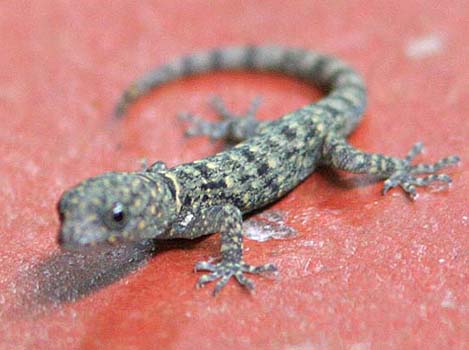 From
these large and mid-sized lizards, we move to some small species:
geckos. This baby (right) was
absolutely tiny. It was walking across the floor of Rio Tigre lodge, a
wonderful spot where the adult geckos hide behind the storage jars in
the storeroom (male, below left) or peak through a crack at the top of
banister (male, below right; females lack the colorful head). All are Red-headed Gecko Gonatodes albogularis,
a species that is called Yellow-headed Gecko elsewhere, such as in the
Caribbean and where introduced in Florida. Those populations have males with
yellowish instead orange-red heads. When this sort of problem crops up
in the bird world, we usually adopt some compromise, like
"Bright-headed Gecko." From
these large and mid-sized lizards, we move to some small species:
geckos. This baby (right) was
absolutely tiny. It was walking across the floor of Rio Tigre lodge, a
wonderful spot where the adult geckos hide behind the storage jars in
the storeroom (male, below left) or peak through a crack at the top of
banister (male, below right; females lack the colorful head). All are Red-headed Gecko Gonatodes albogularis,
a species that is called Yellow-headed Gecko elsewhere, such as in the
Caribbean and where introduced in Florida. Those populations have males with
yellowish instead orange-red heads. When this sort of problem crops up
in the bird world, we usually adopt some compromise, like
"Bright-headed Gecko." |
|
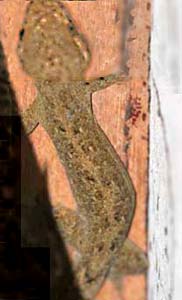 When
Liz, the owner of Rio Tigre lodge, saw that I was interested in the
geckos, she invited me to look for the other gecko she often
encountered in her "office," an open-air two-story building with a roof
but no exterior walls. We searched the sides and backs of closets and
half-walls, moving boxes and the like, until she saw where one was.
Then I shot photos rather 'blindly' down the narrow opening, with my
flash, hoping something would show on the image. If we moved the box
so far out as to expose the lizard, it would immediately run away into
the cracks. Using this technique I got two half-images of Turnip-tailed Gecko Thecadactylus rapicauda
(right) but never the whole thing. This image (right) is a composite of
two shot (one was just the body, one was just the head). This species
was quite large for geckos in my brief experience, but are understand
that geckos can be much larger in Madagascar or New Caledonia. When
Liz, the owner of Rio Tigre lodge, saw that I was interested in the
geckos, she invited me to look for the other gecko she often
encountered in her "office," an open-air two-story building with a roof
but no exterior walls. We searched the sides and backs of closets and
half-walls, moving boxes and the like, until she saw where one was.
Then I shot photos rather 'blindly' down the narrow opening, with my
flash, hoping something would show on the image. If we moved the box
so far out as to expose the lizard, it would immediately run away into
the cracks. Using this technique I got two half-images of Turnip-tailed Gecko Thecadactylus rapicauda
(right) but never the whole thing. This image (right) is a composite of
two shot (one was just the body, one was just the head). This species
was quite large for geckos in my brief experience, but are understand
that geckos can be much larger in Madagascar or New Caledonia. |
 Then there is the gecko grabbed by the Bright-rumped Atila in our title photo. John Sullivan identifies it in this photo as House Gecko Hemidactylus frenatus,
an introduced species native to southeast Asia. There was no photo of
it in Savage (2002) but that book does explain it has been showing up
in Costa Rica since 1990. So, quite by accident, this turns out to be a
photograph of the good-guy native bird preying upon the bad-guy
non-native exotic! Then there is the gecko grabbed by the Bright-rumped Atila in our title photo. John Sullivan identifies it in this photo as House Gecko Hemidactylus frenatus,
an introduced species native to southeast Asia. There was no photo of
it in Savage (2002) but that book does explain it has been showing up
in Costa Rica since 1990. So, quite by accident, this turns out to be a
photograph of the good-guy native bird preying upon the bad-guy
non-native exotic! |
|
| |
|
 The
last group of lizards from this trip is the anoles. These are
definitely tropical species, with a fine assortment in Costa Rica. Slender Anole Norops limifrons
was quite common at La Selva (above). Its life history has been studied
there in detail, where it is considered a 'weed' species; i.e., most
abundant in open, disturbed habitats (Savage 2002). At Bosque del Rio
Tigre on the Osa Peninsula, Golfo Dulce Anole Norops polylepis
is plentiful inside the forest. I got this lucky shot of a female
(right) just about to snatch a meal. But what is really special
about anoles is limited to males when they are courting, and is
illustrated in the photos below. The dull little male is, at one
moment, just sitting there quietly and unobtrusively and then, the next
moment, zaazoooom! He holds the pose for several seconds, and then the
dewlap is quickly withdrawn. Fully mature males spend half their time
displaying or fighting with other males (Savage 2002). The
last group of lizards from this trip is the anoles. These are
definitely tropical species, with a fine assortment in Costa Rica. Slender Anole Norops limifrons
was quite common at La Selva (above). Its life history has been studied
there in detail, where it is considered a 'weed' species; i.e., most
abundant in open, disturbed habitats (Savage 2002). At Bosque del Rio
Tigre on the Osa Peninsula, Golfo Dulce Anole Norops polylepis
is plentiful inside the forest. I got this lucky shot of a female
(right) just about to snatch a meal. But what is really special
about anoles is limited to males when they are courting, and is
illustrated in the photos below. The dull little male is, at one
moment, just sitting there quietly and unobtrusively and then, the next
moment, zaazoooom! He holds the pose for several seconds, and then the
dewlap is quickly withdrawn. Fully mature males spend half their time
displaying or fighting with other males (Savage 2002). |
|
|
|
| |
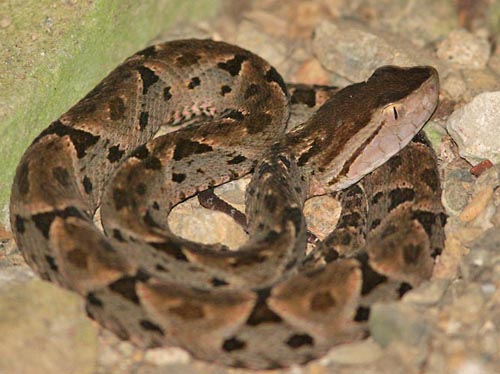 We
had only two snakes this trip, but both of them were famed venomous
snakes so were major highlights. Both were on the Osa Peninsula, in the
Pacific slope rainforest. The first (right) is the infamous Western Fer-de-lance Bothrops asper.
It was just a baby, and asleep (during the day), but still impressive.
It is obviously beautifully patterned, but it is the recognition that
this is the most dangerous snake in the New World that is frightening.
Stories from Alan Rabinowitz's jaguar research in Belize (1986) are
chilling. Recent research on poison toxicology supports a split of this
species from the Eastern (or Amazonian) Fer-de-lance B. atrox
(Savage 2002). This is an aggressive snake but mostly nocturnal. Over
half the snakebites in Costa Rica are attributed to it, with 15-20
deaths each year (Savage 2002). I had also wanted to see one . . .
safely. We
had only two snakes this trip, but both of them were famed venomous
snakes so were major highlights. Both were on the Osa Peninsula, in the
Pacific slope rainforest. The first (right) is the infamous Western Fer-de-lance Bothrops asper.
It was just a baby, and asleep (during the day), but still impressive.
It is obviously beautifully patterned, but it is the recognition that
this is the most dangerous snake in the New World that is frightening.
Stories from Alan Rabinowitz's jaguar research in Belize (1986) are
chilling. Recent research on poison toxicology supports a split of this
species from the Eastern (or Amazonian) Fer-de-lance B. atrox
(Savage 2002). This is an aggressive snake but mostly nocturnal. Over
half the snakebites in Costa Rica are attributed to it, with 15-20
deaths each year (Savage 2002). I had also wanted to see one . . .
safely. |
| The other venomous viper I had hoped to see was this one: Eyelash Viper Bothriechis schlegelii
(right & below). We had seen it or a similar species years ago in
Ecuador, but didn't have a camera then. This individual had been
spotted during a hike in the forest at Rio Tigre by another group, but
we prevailed on Abram to take us back in the afternoon and, by luck,
the viper was still there, asleep on a palm frond. The near photo was
taken with natural light, the other (far right) with flash. |
|
|
|
| There
is naturally great individual variation in color patterns, from green
to bright yellow to this one, a mosaic of colors. This was a fairly
small snake, probably just 1 foot to 1.5 ft long. Because it sleeps on
day roosts just a couple feet off the ground, like this one, snakebites
are fairly common by those moving through the forest without paying
close attention (90-100 reported bites/year in Costa Rica). However,
due to its small size, fatalities are few (but can be up to 3-6 a year
in Costa Rica; Savage 2002). This is an arboreal, nocturnal predator
that feeds to frogs, anoles, birds, small mammals, and bats. It is
named for the modified scales over each eye; a close-up of the head is
below. |
|
Literature cited:
- Heinicke,
M.P., W.E. Duellman, and S.B. Hedges. 2007. Major Caribbean and Central
American frog faunas originated by ancient oceanic dispersal. Proc.
Nat. Acad. Sci. 104: 10092-10097; available on-line
- Miyamoto, M.M. 1983. Biochemical variation in
the frog Eleutherodactylus bransfordii: geographic patterns and cryptic
species. System. Zool. 32: 43-51.
- Rabinowitz, A. 1986. Jaguar: Struggle and Triumph in the Jungles of Belize. Arbor House, New York.
- Savage, J.M. 2002. The Amphibians and Reptiles
of Costa Rica: a Herpetofauna between Two Continents, between Two Seas.
Univ. Chicago Press, Chicago.
- Smith,
H.M., and D. Chiszar. 2006. Dilema of name recognition: why and when to
use new combinations of scientific names. Herp. Cons. Biol. 1: 6-8; available on-line
|
|
|
|


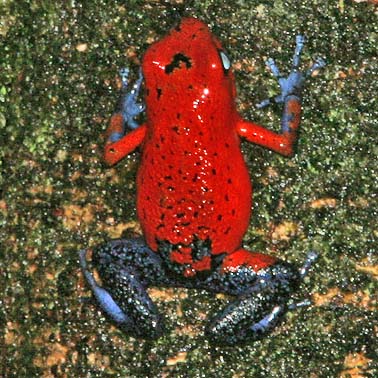
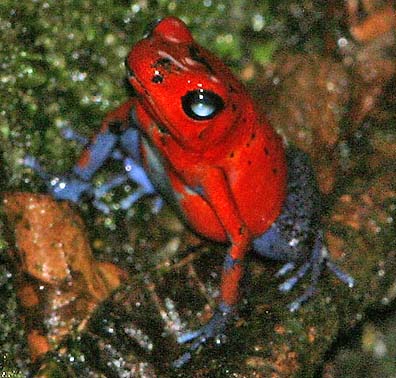

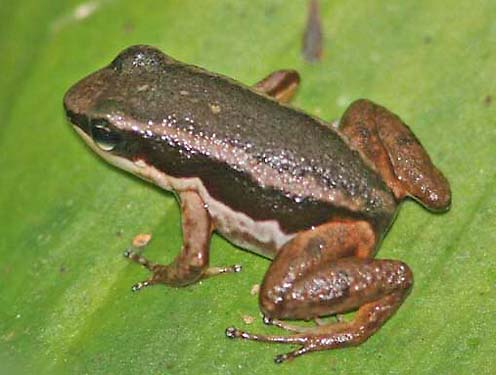
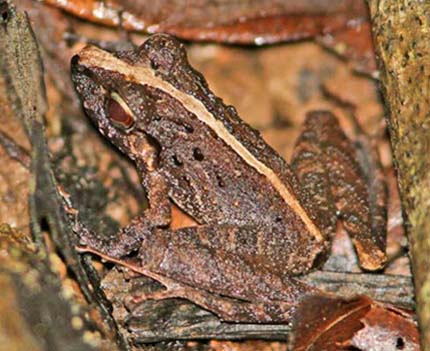
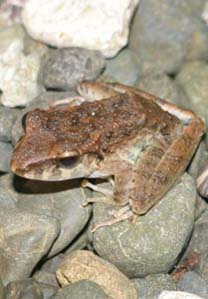


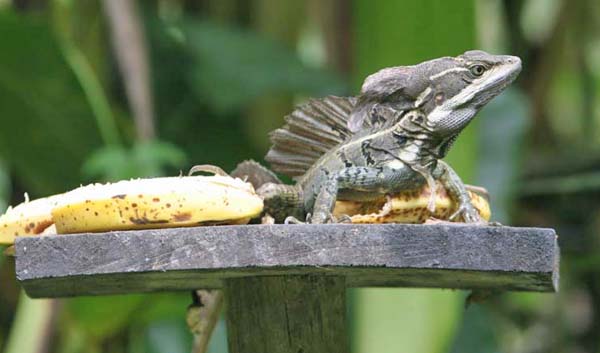
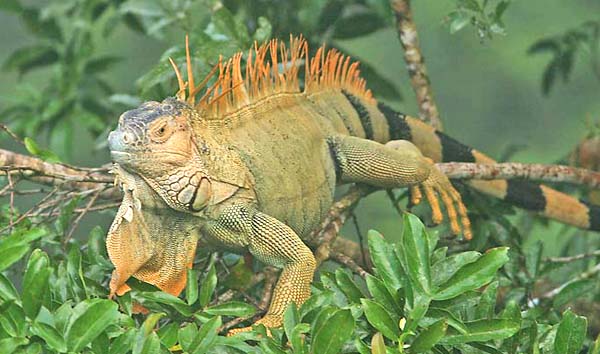

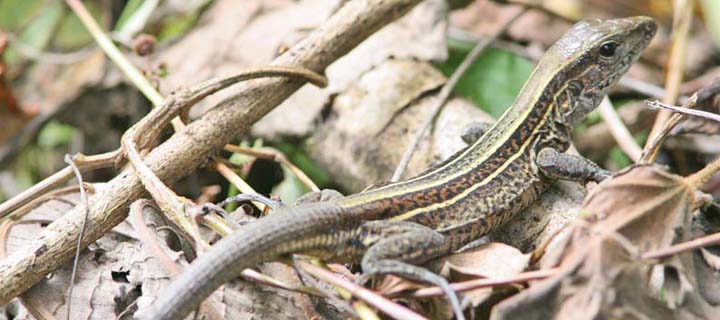
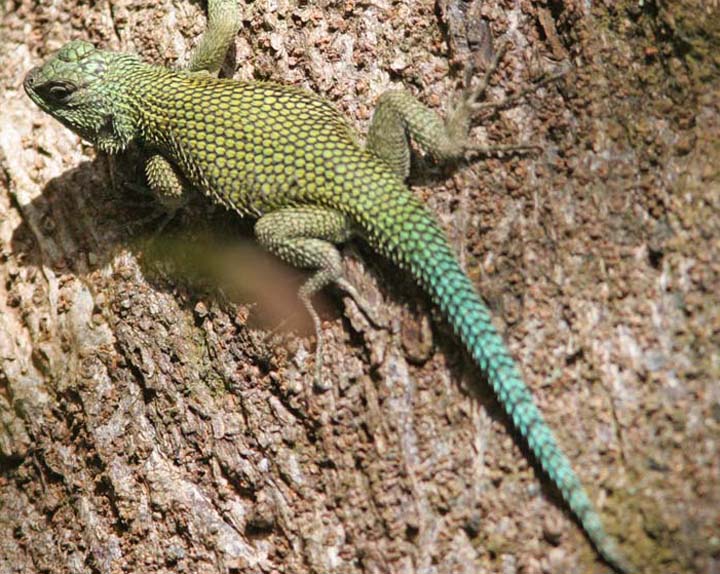
 From
these large and mid-sized lizards, we move to some small species:
geckos. This baby (right) was
absolutely tiny. It was walking across the floor of Rio Tigre lodge, a
wonderful spot where the adult geckos hide behind the storage jars in
the storeroom (male, below left) or peak through a crack at the top of
banister (male, below right; females lack the colorful head). All are Red-headed Gecko Gonatodes albogularis,
a species that is called Yellow-headed Gecko elsewhere, such as in the
Caribbean and where introduced in Florida. Those populations have males with
yellowish instead orange-red heads. When this sort of problem crops up
in the bird world, we usually adopt some compromise, like
"Bright-headed Gecko."
From
these large and mid-sized lizards, we move to some small species:
geckos. This baby (right) was
absolutely tiny. It was walking across the floor of Rio Tigre lodge, a
wonderful spot where the adult geckos hide behind the storage jars in
the storeroom (male, below left) or peak through a crack at the top of
banister (male, below right; females lack the colorful head). All are Red-headed Gecko Gonatodes albogularis,
a species that is called Yellow-headed Gecko elsewhere, such as in the
Caribbean and where introduced in Florida. Those populations have males with
yellowish instead orange-red heads. When this sort of problem crops up
in the bird world, we usually adopt some compromise, like
"Bright-headed Gecko." 
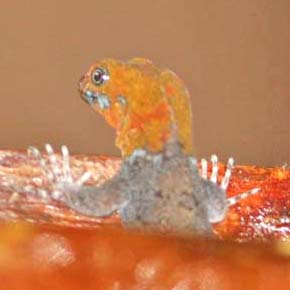
 When
Liz, the owner of Rio Tigre lodge, saw that I was interested in the
geckos, she invited me to look for the other gecko she often
encountered in her "office," an open-air two-story building with a roof
but no exterior walls. We searched the sides and backs of closets and
half-walls, moving boxes and the like, until she saw where one was.
Then I shot photos rather 'blindly' down the narrow opening, with my
flash, hoping something would show on the image. If we moved the box
so far out as to expose the lizard, it would immediately run away into
the cracks. Using this technique I got two half-images of Turnip-tailed Gecko Thecadactylus rapicauda
(right) but never the whole thing. This image (right) is a composite of
two shot (one was just the body, one was just the head). This species
was quite large for geckos in my brief experience, but are understand
that geckos can be much larger in Madagascar or New Caledonia.
When
Liz, the owner of Rio Tigre lodge, saw that I was interested in the
geckos, she invited me to look for the other gecko she often
encountered in her "office," an open-air two-story building with a roof
but no exterior walls. We searched the sides and backs of closets and
half-walls, moving boxes and the like, until she saw where one was.
Then I shot photos rather 'blindly' down the narrow opening, with my
flash, hoping something would show on the image. If we moved the box
so far out as to expose the lizard, it would immediately run away into
the cracks. Using this technique I got two half-images of Turnip-tailed Gecko Thecadactylus rapicauda
(right) but never the whole thing. This image (right) is a composite of
two shot (one was just the body, one was just the head). This species
was quite large for geckos in my brief experience, but are understand
that geckos can be much larger in Madagascar or New Caledonia.  Then there is the gecko grabbed by the Bright-rumped Atila in our title photo. John Sullivan identifies it in this photo as House Gecko Hemidactylus frenatus,
an introduced species native to southeast Asia. There was no photo of
it in Savage (2002) but that book does explain it has been showing up
in Costa Rica since 1990. So, quite by accident, this turns out to be a
photograph of the good-guy native bird preying upon the bad-guy
non-native exotic!
Then there is the gecko grabbed by the Bright-rumped Atila in our title photo. John Sullivan identifies it in this photo as House Gecko Hemidactylus frenatus,
an introduced species native to southeast Asia. There was no photo of
it in Savage (2002) but that book does explain it has been showing up
in Costa Rica since 1990. So, quite by accident, this turns out to be a
photograph of the good-guy native bird preying upon the bad-guy
non-native exotic! 
 The
last group of lizards from this trip is the anoles. These are
definitely tropical species, with a fine assortment in Costa Rica. Slender Anole Norops limifrons
was quite common at La Selva (above). Its life history has been studied
there in detail, where it is considered a 'weed' species; i.e., most
abundant in open, disturbed habitats (Savage 2002). At Bosque del Rio
Tigre on the Osa Peninsula, Golfo Dulce Anole Norops polylepis
is plentiful inside the forest. I got this lucky shot of a female
(right) just about to snatch a meal. But what is really special
about anoles is limited to males when they are courting, and is
illustrated in the photos below. The dull little male is, at one
moment, just sitting there quietly and unobtrusively and then, the next
moment, zaazoooom! He holds the pose for several seconds, and then the
dewlap is quickly withdrawn. Fully mature males spend half their time
displaying or fighting with other males (Savage 2002).
The
last group of lizards from this trip is the anoles. These are
definitely tropical species, with a fine assortment in Costa Rica. Slender Anole Norops limifrons
was quite common at La Selva (above). Its life history has been studied
there in detail, where it is considered a 'weed' species; i.e., most
abundant in open, disturbed habitats (Savage 2002). At Bosque del Rio
Tigre on the Osa Peninsula, Golfo Dulce Anole Norops polylepis
is plentiful inside the forest. I got this lucky shot of a female
(right) just about to snatch a meal. But what is really special
about anoles is limited to males when they are courting, and is
illustrated in the photos below. The dull little male is, at one
moment, just sitting there quietly and unobtrusively and then, the next
moment, zaazoooom! He holds the pose for several seconds, and then the
dewlap is quickly withdrawn. Fully mature males spend half their time
displaying or fighting with other males (Savage 2002). 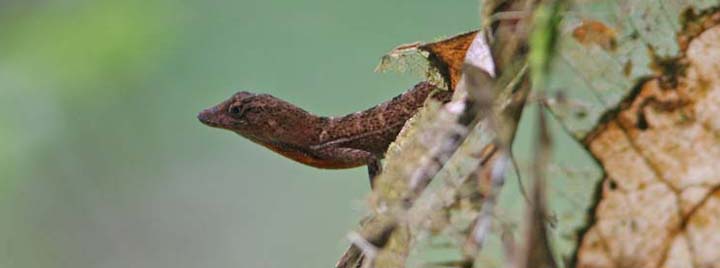
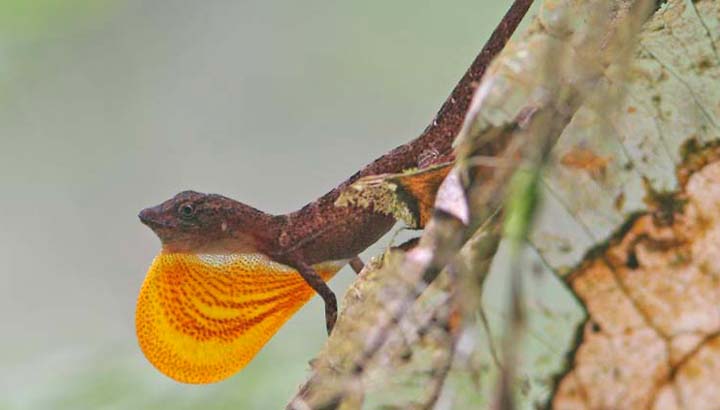
 We
had only two snakes this trip, but both of them were famed venomous
snakes so were major highlights. Both were on the Osa Peninsula, in the
Pacific slope rainforest. The first (right) is the infamous Western Fer-de-lance Bothrops asper.
It was just a baby, and asleep (during the day), but still impressive.
It is obviously beautifully patterned, but it is the recognition that
this is the most dangerous snake in the New World that is frightening.
Stories from Alan Rabinowitz's jaguar research in Belize (1986) are
chilling. Recent research on poison toxicology supports a split of this
species from the Eastern (or Amazonian) Fer-de-lance B. atrox
(Savage 2002). This is an aggressive snake but mostly nocturnal. Over
half the snakebites in Costa Rica are attributed to it, with 15-20
deaths each year (Savage 2002). I had also wanted to see one . . .
safely.
We
had only two snakes this trip, but both of them were famed venomous
snakes so were major highlights. Both were on the Osa Peninsula, in the
Pacific slope rainforest. The first (right) is the infamous Western Fer-de-lance Bothrops asper.
It was just a baby, and asleep (during the day), but still impressive.
It is obviously beautifully patterned, but it is the recognition that
this is the most dangerous snake in the New World that is frightening.
Stories from Alan Rabinowitz's jaguar research in Belize (1986) are
chilling. Recent research on poison toxicology supports a split of this
species from the Eastern (or Amazonian) Fer-de-lance B. atrox
(Savage 2002). This is an aggressive snake but mostly nocturnal. Over
half the snakebites in Costa Rica are attributed to it, with 15-20
deaths each year (Savage 2002). I had also wanted to see one . . .
safely. 